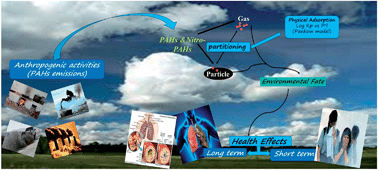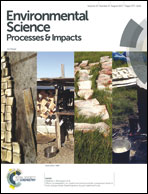Atmospheric concentrations and gas–particle partitioning of polycyclic aromatic hydrocarbons (PAHs) and nitro-PAHs at Indo-Gangetic sites†
Abstract
Aerosol samples in the dual-phase (gaseous and particulate) were collected simultaneously for the first time in Agra at a rural and a traffic dominated site during post-monsoon and winter seasons to investigate the gas–particle partitioning of polycyclic aromatic hydrocarbons (PAHs). The samples were collected using a high volume sampler on quartz micro-fiber filter papers and polyurethane foam plugs for particulate and gas phases respectively. The samples were extracted in a mixture of DCM and n-hexane. 16 priority PAHs and two nitro-PAHs were analyzed using gas chromatograph-mass spectrometry. The total concentration of PAHs (gas + particulate) was 4015 and 624 ng m−3 at the traffic and rural sites respectively. Two and three ring PAHs were dominant in the gas phase while four, five and six ring PAHs were abundant in the particle phase. A statistically significant correlation (r2 = 0.69–0.98, p < 0.001) for log Kpvs. was obtained for individual PAHs at both sites where slopes varied between −2.83 and −0.04 at the traffic site and from −3.15 to −0.06 at the rural site. Regression statistics of Clausius–Clapeyron plots suggest that the concentration of highly volatile PAHs in the atmosphere is influenced by temperature. The gas–particle partitioning coefficient Kp in its logarithmic form correlated with 1/T (r2 = 0.5–0.95, p < 0.001) and a positive slope for individual PAHs was found. In health risk assessment DbA was found to be the most carcinogenic and mutagenic as compared to other PAHs followed by BaP. 1-NPyr had a larger contribution to BaP-TEQ than 3-NFla.
was obtained for individual PAHs at both sites where slopes varied between −2.83 and −0.04 at the traffic site and from −3.15 to −0.06 at the rural site. Regression statistics of Clausius–Clapeyron plots suggest that the concentration of highly volatile PAHs in the atmosphere is influenced by temperature. The gas–particle partitioning coefficient Kp in its logarithmic form correlated with 1/T (r2 = 0.5–0.95, p < 0.001) and a positive slope for individual PAHs was found. In health risk assessment DbA was found to be the most carcinogenic and mutagenic as compared to other PAHs followed by BaP. 1-NPyr had a larger contribution to BaP-TEQ than 3-NFla.



 Please wait while we load your content...
Please wait while we load your content...